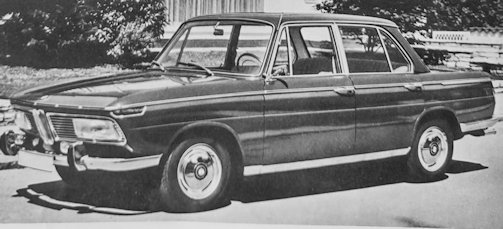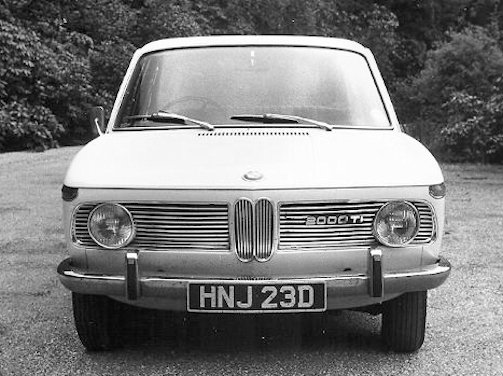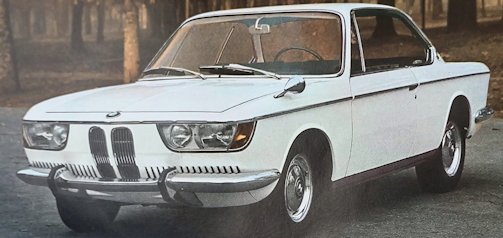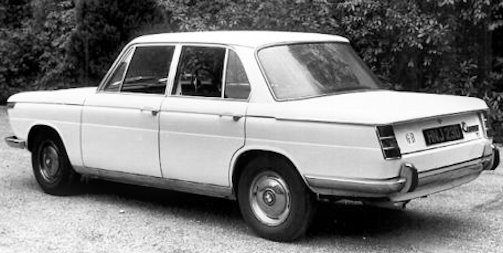BMW 2000 New class
 | |
Production period: | 1966 to 1972 |
Class: | Motor Car |
Body versions: | Sedan, coupe |
Engines: | Petrol 2.0 litres (59–96 kW) |
Length: | 4500-4530mm |
Broad: | 1675-1710mm |
Height: | 1360-1450mm |
wheelbase: | 2550mm |
curb weight: | 1040-1180kg |
The BMW New Class internal model designations 120 (2000 Coupé), 121 (2000)) was a new series from the automobile manufacturer BMW in the 1960s and 1970s.
History
The "2000 New Class" was produced from summer 1966 to spring 1972 and was then replaced by the first generation of the BMW 5 Series (E12).
Six months after the presentation of the BMW 2000 CA coupe (type 120), the four-door BMW 2000 sedan (type 121) appeared in early 1966 with a slightly different shape compared to the BMW 1800: instead of simple round headlights, there were wider, rectangular headlights, as well as larger rear lights. The chassis was the reinforced version already used on the 2000 Coupé.
From mid-1966 there was also a sportier BMW 2000 TI variant with two double carburettors and 120 hp (88 kW), which, like the BMW 1800 TI, had round headlights and narrow rear lights, and a more luxuriously equipped BMW 2000 TI-lux variant (later "tilux “) with the same engine but the body of the BMW 2000 with rectangular headlights. In 1968 there were various improvements to the chassis, see BMW 1800. The BMW 2000 tilux was replaced in late 1969 by the 2000 tii. Its engine produced 130 hp (96 kW) and was the first BMW engine with manifold injection. The second "i" stands for the mechanical Kugelfischer fuel injection ("injection").
In 1966, Hubert Hahne was the first touring car driver to lap the Nürburgring Nordschleife in under ten minutes in a BMW 2000 TI. In a support race for the German Grand Prix on August 6, 1966, he drove the route in 9:58.5 (or 9:58.9) minutes. In the same year, in a BMW 2000 TI, he won the 24-hour race at Spa-Francorchamps together with Jacky Ickx and was also European Touring Car Champion.

BMW New class coupe 2000 C/CA/CS
The new class coupé designed by BMW designer Wilhelm Hofmeister (“Hofmeister-Knick”) was presented in June 1965 as a “comfortable touring car with a sporty heart for long journeys”. It was not until November 22, 1965 that Karmann in Osnabrück started producing the coupe bodies.
The chassis largely corresponded to that of the previous sedan types. The 1.8-liter four-cylinder was bored out to 2.0-liter, whereby the shape of the combustion chamber was redesigned and flow resistance was further reduced by modified intake paths. The new engine was supplemented by a Solex double carburettor. It was available with 120 hp in the BMW 2000 CS (Type 120) and with 100 hp in the BMW 2000 CA with a three-speed automatic transmission. The car was offered as a BMW 2000 C with 100 hp and manual transmission from May 1967 to 1968. Only 443 BMW 2000 Cs were made. Although the BMW 2800 CS (E9 series) was presented in September 1968, the BMW 2000 CA and CS remained in the BMW range as a reasonably priced alternative until the mid-1970s.At Wilhelm Karmann GmbH, between November 22, 1965 and July 11, 1970, exactly 13,151 body shells left the plant, and between August 18, 1968 and February 24, 1970 exactly 549 complete vehicles, i.e., a total of 13,700 new class vehicles. coupes.

The silver-grey colour available for the BMW 2000 coupe (called "Polaris new" at BMW) was unusual in the street scene of the time, and the car was often ordered in this colour along with the colour "Chamonix" (ivory).
PERFORMANCE
Engine capacity: 121.43 cu in, 1,990 cu cm
Fuel consumption: 26.4 ml imp gal, 22 ml US gal, 10.7 x 100 km
Max speed:104.4 mph, 168 km/h
max power (SAE): 113 hp at 5,800 rpm
max torque (DIN): 116 1b ft, 16 kg m at 3,000 rpm
max engine rpm: 6,200
specific power: 56.8 hp/l
power-weight ratio: 22 lb/hp, 10 kg/hp
carrying capacity: 882 1b, 400 kg
acceleration: standing 1/4 mile 18.5 sec, O— 50 mph (0 —80 km/h)sec
speed in direct drive at 1,000 rpm: 17 mph, 27.4 km/h.
max speeds: 27.3 mph, 44 km/h in 1st gear; 51.6 mph, 83 km/h in 2nd gear; 78.3 mph, 126 km/h in 3rd gear; 104.4 mph, 168 km/h in 4th gear
Ti
max power (SAE) 135 hp at 5,800 rpm
max torque (DIN) 123 1b ft. 17 kg m at 3,600 rpm
67.8 hp/l specific power
power-weight ratio 17.9 lb/hp, 8.1 kg/hp,
acceleration standing 1/4 mile 17.6 sec, O—50 mph (O—80 km/h) 7.3 sec
max speed (I) 29.8 mph, 48 km/h, (II) 55.3 mph, 89 km/h, (III) 84.5 mph, 136 km/h, (IV) 111.8 mph,180 km/h
fuel consumption 25.7 m/imp gal, 21.4 ml US gal
Year | 1965 | 1966 | 1967 | 1968 | 1969 | 1970 | 1971 | 1972 | 1973 | 1974 | total |
2000 | 57 | 43,431 | 34,418 | 26,350 | 22,420 | 17,625 | 10,603 | 337 |
|
| 181,591 |
2000 CKD |
| 1,494 | 1,078 | 1.184 | 1,846 | 1,670 | 725 | 689 | 1,036 | 372 | 11,764 |
2000cs | 57 | 7.192 | 3,800 | 1,641 | 822 | 179 |
|
|
|
| 9,999 |

Rating
Technical
-
BMW 2000 New class Technical details and specifications (1966-1972)
ENGINE
front, 4 stroke; cylinders: 4, slanted at 300, in line
bore and stroke: 3.50 x 3.15 in, 89 x 80 mm
engine capacity: 121.43 cu in, 1,990 cu cm
compression ratio: 8.5 Ti 9.3
cylinder block: cast iron: cylinder head: light alloy, hemispherical combustion chambers
crankshaft bearings: 5
valves: 2 per cylinder, overhead, Vee-slanted at 520, rockers
camshafts :I, overhead
lubrication: mechanical pump, full flow filter
carburation: 1 Solex 40 PDSI downdraught carburettor
Ti 2 Solex 40 PHH horizontal twin barrel carburettors
fuel feed: mechanical pump
cooling system: water
TRANSMISSION
driving wheels: rear
clutch: single dry plate, hydraulically controlled
gearbox: mechanical; gears: 4 + reversesynchromesh gears: l, I Ill, IV
gearbox ratios: 1 3.835, Il 2.053, Ill 1.345, IV 1, rev 4.180
gear lever: central;
final drive: hypoid bevel
axle ratio: 4.110. Ti 3.900 axle ratio
(Optional) ZF automatic gearbox, with 3 ratios (I 2.560,II 1.520, III 1, rev 2),CHASSIS
integral
front suspension: independent by McPherson, coil springs/telescopic damper struts, lower wishbones, lower trailing links
rear suspension:independent, oblique semi-trailing arms, coil springs, rubber springs, telescopic dampers.
Ti anti-roll bar on front and rear suspensionsSTEERING
worm and roller
turns of steering wheel lock to lock: 3.50.
turning circle (between walls): 34.4 ft, 10.5 mBRAKES
front disc (diameter 10.71 in, 272 mm), rear drum, servo.ELECTRICAL EQUIPMENT
voltage: 12 V
battery: 44 Ah
generator type: alternator, 500 W
ignition distributor: Bosch
headlamps: 2.DIMENSIONS AND WEIGHT
wheel base: 88.58 in, 2,250 mm
front track: 52.36in, 1,330 mm
rear track: 54.17 in, 1,376 mm
overall length: 177.16 in, 4,500 mm
overall width: 67.32 in, 1,710 mm
overall height: 56.89 in, 1,445 mm
ground clearance: 5.51 in, 140 mm
dry weight: 2,492 1b, 1,130 kg Ti dry weight 2,425 1b,1,100 kg
distribution of weight: 54% front axle, 46% rear axleModel overview sedan
Vehicle type:
BMW 2000
Construction time:
1966-1972
TI: 1966-1968
tilux: 1966-1970
tii: 1969-1972Engine:
Four-cylinder four-stroke in - line engine, water-cooled; V-shaped overhead valves controlled by an overhead chain-driven camshaft via rocker arms; aluminium cylinder head; Crankshaft with five bearings
Displacement:
1990cm3 _
Bore × Stroke:
89×80mm
carburettor:
Downdraft carburettor Solex 40 PDSI
TI/tilux: 2 Solex flat-draft twin carburettors 40 PHH
tii: Intake manifold injection Kugelfischer PL 04Compression:
BMW 2000: 8.5:1
BMW 2000 TI/tilux: 9.3:1
BMW 2000 tii: 10:1Performance at 1/min:
74 kW (100 hp) with 5500
TI/tilux: 88 kW (120 hp) with 5500
tii: 96 kW (130 hp) with 5800Torque at 1/min:
157 N m (16 kp m) at 3000
TI/tilux: 167 N m (17 kp m) at 3600
tii: 177 N m (18 kp m) at 4000-4700Drive:
Fully synchronized four-speed gearbox (1800 TI/SA: five-speed), 1800/2000: also, three-speed automatic
body:
Load-bearing all-steel body welded to the floor assembly
landing gear:
independent suspension; front: wishbone with spring struts, stabilizer on request; rear: trailing arm with coil springs, telescopic shock absorber; Disc brakes at the front, drum brakes at the rear.
Dimensions L × W × H:
4500 × 1710 × 1450 mm (1420 mm loaded)
Curb weight (ready to drive):
BMW 2000: 1150 kg
. BMW 2000 TI/tilux: 1130 kg.
BMW 2000 tii: 1140 kgTop speed:
168 km/h
TI/tilux: 180 km/h
tii: 185 km/hNumber of pieces:
143,464
Model overview coupe
Vehicle type:
BMW 2000 C, CA (automatic)
Construction time:
C: 1967-1968
CA: 1965-1970Engine:
Four-cylinder, four-stroke in-line engine, water-cooled; V-shaped overhead valves controlled by an overhead chain-driven camshaft via rocker arms; aluminium cylinder head; Crankshaft with five bearings
Displacement:
1990cm3 _
Bore × Stroke:
89×80mm
carburettor:
1 downdraft carburettor Solex 40 PDSI
Compression:
8.5:1
Performance at 1/min:
74 kW (100 hp) at 5500
Torque at 1/min:
157 Nm (16 mkp) at 3000
Drive:
Fully synchronized four-speed gearbox (type 2000 C and CS) or three-speed automatic with hydraulic converter (type 2000 CA)
body:
Self-supporting all-steel body
landing gear:
Independent suspension (front wishbone with struts; rear semi-trailing arm with coil springs; type 2000 CS v+h stabilizer), telescopic shock absorber
wheelbase:
2550mm
Dimensions L × W × H:
4530 × 1675 × 1360 mm (1330 mm loaded)
Curb weight (ready to drive):
1180kg
Top speed:
172km/h
Acceleration (0-100 km/h):
15 s (with automatic)
Quantity:
3249 (2000CA); 443 (2000C)
Vehicle type:
BMW 2000 CS
Construction time:
1965-1970
Engine:
Four-cylinder, four-stroke in-line engine, water-cooled; V-shaped overhead valves controlled by an overhead chain-driven camshaft via rocker arms; aluminium cylinder head; Crankshaft with five bearings
Displacement:
1990cm3 _
Bore × Stroke:
89×80mm
carburettor:
2 flat-flow twin carburettors
Solex 40 PHHCompression:
9.3:1
Performance at 1/min:
88 kW (120 hp) at 5500
Torque at 1/min:
167 Nm (17 mkp) at 3600
Drive:
Fully synchronized four-speed gearbox (type 2000 C and CS) or three-speed automatic with hydraulic converter (type 2000 CA)
body:
Self-supporting all-steel body
landing gear:
Independent suspension (front wishbone with struts; rear semi-trailing arm with coil springs; type 2000 CS v+h stabilizer), telescopic shock absorber
wheelbase:
2550mm
Dimensions L × W × H:
4530 × 1675 × 1360 mm (1330 mm loaded)
Curb weight (ready to drive):
1180kg
Top speed:
185km/h
Acceleration (0-100 km/h):
10.5s
Quantity:
9999
© Motor car History
-
BMW 2000 New class Maintenance and Service Guide (1966-1972)
fuel: 98 oct petrol
engine sump oil: 7.04 imp pt, 8.46 US pt, 4 1, SAE 10W-30, change every 3,700 miles, 6,000 km
total lubricating system capacity: 7.39 imp pt. 8.88 US pt, 4.2 1
gearbox oil:1.76 imp pt, 2.11 US pt, 1 1, SAE 80, change every 14,900 miles, 24,000 km
final drive oil: 1.58 imp pt, 1.90 US pt, 0.91, SAE 90, change every 14,900 miles, 24,000 km
greasing: every 3,700 miles, 6,000 km, 4 points
cooling system capacity: 12.32 imp pt, 14.80 US pt, 7 1.
tappet clearances. inlet 0.006 - 0.008 in, 0.15 - 0.20 mm, exhaust 0.006 - 0.008 in, 0.15-0.20 mm;
valve timing: inlet opens 4° before tdc and closes 52° after bdc, exhaust opens 52° before bdc and closes 4° after tdc
normal tyre pressure: front 24 psi, 1.7 atm, rear 26 psi, 1.8 atm.
width of rims: 5" Ti 5.5" wide rims
tyres: 6.45 x 14 or 165 x 14 Ti 6,95/175 x 14 tyres
fuel tank capacity: 12.1 imp gal, 14.5 US gal, 55 1.© Motor car History




